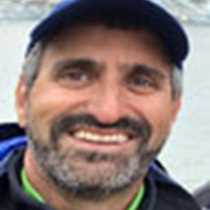San Jose Channel and Isla San Francisco
Blue night dawned orange and the leading edge of the sun flashed first blue then green as it rose out of a crystal clear horizon. With the new light we were soon fortunate to discover a pair of blue whales. These largest of beasts surely can be hard to find, and incredibly, even hard to discern in the sea surface, blue whales melding into blue waters.
Today we were in luck; there was a blue whale calf before us! At birth, baby blues can be 25 feet long and weigh four tons. It is pure inspiration to see the next generation of one of our planet’s icons, especially given the brutally low population numbers in the aftermath of 20th century whaling.
Southwest Sea of Cortez is one of a few places in the world where blue whales can be reliably found. Researchers are honing in on the migrations of these open water leviathans; current thought is that some blues bear their young in an oceanographically defined area hundreds of miles west of Costa Rica before venturing north in winter to visit productive waters here in the Sea of Cortez. They then continue to the west coast of the Baja California peninsula in spring before reaching summer krill blooms off California’s continental shelf break. The discovery that these enormous whales appear to follow a path that provides them food resources throughout the year makes them different from other baleen whales like the humpbacks and grays we saw this week that may endure a winter fast.
Linnaeus, father of scientific nomenclature, named this remarkable animal Balaenoptera musculus – meaning either ‘winged whale with muscles’ or, as some believe, in jest as ‘winged whale like a mouse.’ Our mother-calf pair seemed to be playing cat and mouse with us, always resurfacing a good distance away, before we deciphered their pattern of making a huge clockwise loop in this area of food resources. Our long encounter with these blues climaxed with a beautiful fluke-up dive by the mother right in front of us (see photo). Her beautiful airfoil-like tail powers her enormous body great distances through the seas.
While awed by the blue whales, we also spotted small dorsal-finned cetaceans floating log-like on the smooth surface. These Kogia or dwarf sperm whales are small, curious, and rarely seen animals that have a spermaceti organ in their heads like sperm whales, false gill slits in imitation of sharks, and will kick out a cloud of matter under duress like octopus. We were simultaneously seeing both the world’s smallest and largest whale species!
Blue night dawned orange and the leading edge of the sun flashed first blue then green as it rose out of a crystal clear horizon. With the new light we were soon fortunate to discover a pair of blue whales. These largest of beasts surely can be hard to find, and incredibly, even hard to discern in the sea surface, blue whales melding into blue waters.
Today we were in luck; there was a blue whale calf before us! At birth, baby blues can be 25 feet long and weigh four tons. It is pure inspiration to see the next generation of one of our planet’s icons, especially given the brutally low population numbers in the aftermath of 20th century whaling.
Southwest Sea of Cortez is one of a few places in the world where blue whales can be reliably found. Researchers are honing in on the migrations of these open water leviathans; current thought is that some blues bear their young in an oceanographically defined area hundreds of miles west of Costa Rica before venturing north in winter to visit productive waters here in the Sea of Cortez. They then continue to the west coast of the Baja California peninsula in spring before reaching summer krill blooms off California’s continental shelf break. The discovery that these enormous whales appear to follow a path that provides them food resources throughout the year makes them different from other baleen whales like the humpbacks and grays we saw this week that may endure a winter fast.
Linnaeus, father of scientific nomenclature, named this remarkable animal Balaenoptera musculus – meaning either ‘winged whale with muscles’ or, as some believe, in jest as ‘winged whale like a mouse.’ Our mother-calf pair seemed to be playing cat and mouse with us, always resurfacing a good distance away, before we deciphered their pattern of making a huge clockwise loop in this area of food resources. Our long encounter with these blues climaxed with a beautiful fluke-up dive by the mother right in front of us (see photo). Her beautiful airfoil-like tail powers her enormous body great distances through the seas.
While awed by the blue whales, we also spotted small dorsal-finned cetaceans floating log-like on the smooth surface. These Kogia or dwarf sperm whales are small, curious, and rarely seen animals that have a spermaceti organ in their heads like sperm whales, false gill slits in imitation of sharks, and will kick out a cloud of matter under duress like octopus. We were simultaneously seeing both the world’s smallest and largest whale species!




